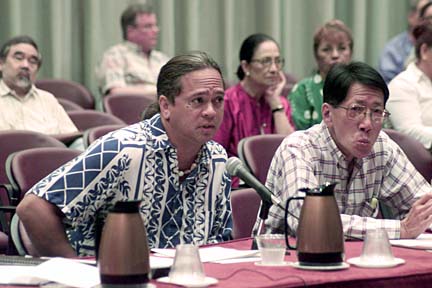
|
Hawaiians call
law too broad
Inouye invites Senate testimony
on dealing with sacred objects
Native Hawaiians testified yesterday that the 1990 federal law designed to help them reclaim sacred items from museums is flawed, shows favoritism and needs to be changed.
![]()

![]()
La'akea Suganuma: Recommends changes to the federal 1990 native graves protection act
Suganuma was one of eight people who recommended changes to the 1990 Native American Graves Protection and Repatriation Act yesterday in a hearing in Honolulu before U.S. Sen. Daniel Inouye.
Changes to definitions in the law are critical in determining who will have the right to reclaim and control burial and sacred objects now held in museums.
Inouye serves as vice chairman of the Senate Committee on Indian Affairs until the new session begins in January. Inouye also drafted and introduced NAGPRA. He held the meeting on behalf of the committee.
Inouye invited the public yesterday to submit written testimony on the issue by Jan. 4. The committee will use the testimony in making suggested revisions.
Several people who testified yesterday said the law works for American Indians who have recognized tribes with governing bodies that are authorized to make decisions on behalf of the entire tribe. Tribal governments can make decisions about how sacred or funerary objects should be treated and even have established tribal museums to house treasures owned by the community.
But to date, native Hawaiians have no such governing body, nor do they have a native Hawaiian museum.
In the absence of tribes, the law's authors came up with "native Hawaiian organization," which many said yesterday is too broadly defined and does not give proper weight to families in the context of Hawaiian culture and in taking care of ancestral remains and items.
"Hawaiian burial practices have always been based on the family and decided by the family," said Cy Harris, who testified that the law needs to be rewritten to strengthen the role of families. He and others said that under NAGPRA, families need to get recognition as a native Hawaiian organization before making a claim.
Harris said the "inadequacy" of NAGPRA definitions has put "decisions into the hands of Hawaiian organizations such as the Office of Hawaiian Affairs and Hui Malama (I Na Kupuna O Hawaii Nei, a group that reburies human remains and sacred items) instead of the native Hawaiian families that should rightfully decide these matters."
NAGPRA defines "native Hawaiian organization" as "any organization which serves and represents the interests of native Hawaiians; has a primary and stated purpose the provision of services to native Hawaiians; and has expertise in native Hawaiian affairs."
A representative from OHA testified that state law gives better emphasis "on the individual and family claimants, rather than the native Hawaiian organization, in recognition of" the importance of the family in burial matters.
Van Horn Diamond, head of another native Hawaiian family group, testified that under NAGPRA, families, nonprofit organizations, cultural groups and royal societies all "get lumped together as native Hawaiian organizations" so that repatriations "are made globally" to the organizations as a group rather than to the claimant who has the closest tie, which is often a family.
Edward Halealoha Ayau, a spokesman for Hui Malama, testified that he was formerly a member of Inouye's staff and helped write NAGPRA and the definition of "native Hawaiian organization."
Ayau said at the time of NAGPRA's drafting, the definition was intentionally made broad to be flexible and inclusive.
"We think it now has to be made narrower," he said.
Ayau recommended that the law should be amended to require that the leadership of any native Hawaiian organization be composed mostly of native Hawaiians.
Current law does not make any ethnic or blood specifications. Some NAGPRA staff members say this was intended so that no anti-discrimination challenges could be raised to slow or defeat passage of the bill.
"It's a complicated legal issue that requires study," said Inouye of Ayau's suggestion and others.
Several people who testified slammed Hui Malama for getting too much power and control over items and their fate.
"This group has arbitrarily imposed their beliefs on everyone else while getting paid for their services," said Suganuma, a longtime critic of Hui Malama.
Ayau said: "We haven't acquired anything. It's all been reburied." He said items that have not been reburied are owned jointly by several groups and are on loan to Bishop Museum. "This isn't about power or authority; it's about kuleana (responsibility)."
Harris, with the Kekumano Ohana, another native Hawaiian family group, said "some groups push their protocols and burial practices with total disregard for family opinions or decision capabilities, have their own agenda based on federal grant money."
Hui Malama, founded a year before the passage of NAGPRA, was one of only two organizations identified as a native Hawaiian organization in the bill when it passed.
Suganuma said Hui Malama "was formed for the express purpose of taking advantage of its (NAGPRA's) provisions and has dominated NAGPRA-related activities without regard for the wishes and beliefs of all others, including those with familial ties, which is contrary to our traditions."
Suganuma said under Hui Malama's favored status, "ownership has been transferred to a few, who can do whatever they want to, even selling it."
huimalama.tripod.com
Bishop Museum
www.bishopmuseum.org
U.S. Interior Dept. -NAGPRA
www.cr.nps.gov/nagpra
[News] [Business] [Features] [Sports] [Editorial] [Do It Electric!]
[Classified Ads] [Search] [Subscribe] [Info] [Letter to Editor]
[Feedback]
